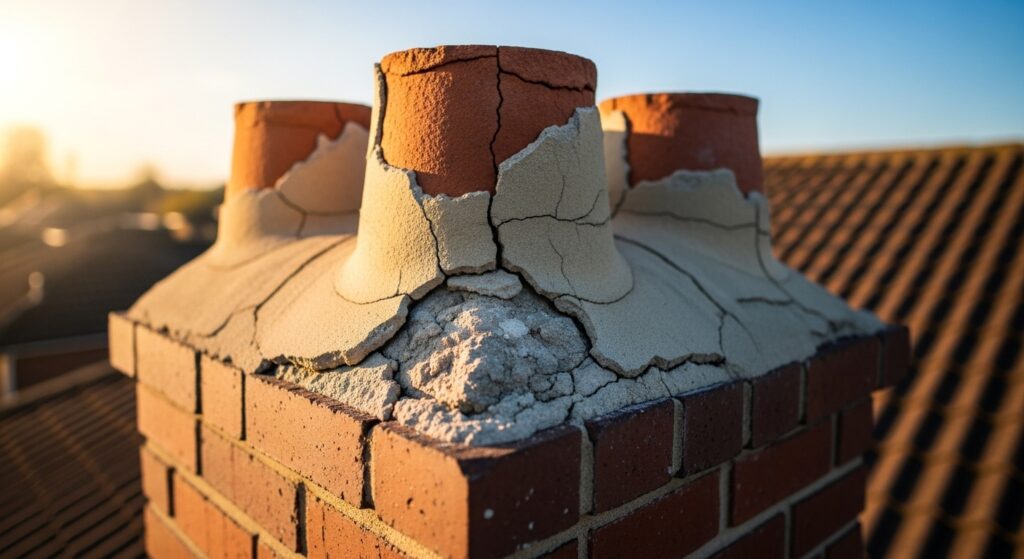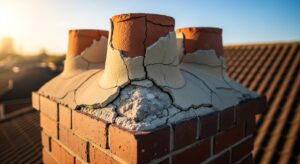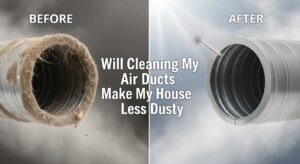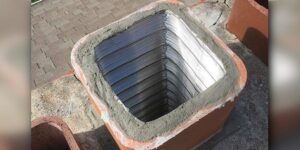A chimney looks strong and unbreakable from the outside, but it consists of multiple parts that need regular repair and maintenance service. One of those parts is the chimney crown. People usually ignore it unless a serious issue arises.
The crown protects the entire structure from water, weather, and damage. Without it, bricks and mortar may wear down. A weak crown can also put your home at risk. That’s why immediate detection of the problem and the right chimney crown repair in Teaneck is important.
In this blog, we will discuss what a chimney crown is and why it needs repair services to keep your home safe.
What Is a Chimney Crown?
A chimney crown sits at the top of the chimney. It works like a hat for your chimney. It covers the top row of bricks and seals the flue opening. The crown stops rain, snow, and ice from going into the chimney structure.
Most crowns are made of concrete, mortar, or stone. They slope slightly to push water away from the chimney sides. When built the right way, a crown extends beyond the edge of the chimney, so the overhang keeps water from running down the bricks.
The crown may look simple, but it plays a big role. Without it, water can soak into the chimney and weaken it from inside out.
Difference Between a Crown and a Cap
Many people confuse a chimney crown with a chimney cap. They sound alike, but they are not the same.
- Crown: A large slab of concrete or mortar that seals the top of the chimney. It covers the full width of the structure.
- Cap: A smaller cover that sits right over the flue opening. Caps are often metal and may have screens to block animals.
The cap prevents birds, leaves, and debris from entering the flue. The crown, on the other hand, protects the brickwork and mortar from rain and snow. Both are important, but the crown is the first line of defense for the entire chimney structure.
Related Resource: What Is a Chimney Liner and Why Does It Matter?
Is Chimney Crown Really Important?
Your chimney faces rough weather every day. Rain, snow, ice, sun, and wind hit it from all sides. Without protection, bricks and mortar soak up water. When temperatures drop, this water freezes, expands, and cracks the masonry. Over time, the chimney weakens and becomes unsafe.
The chimney crown blocks this cycle. It seals the top and keeps water out. If the crown fails, damage spreads quickly. Cracked bricks, falling mortar, and even leaks inside the house often start with a bad crown.
The crown also supports the chimney cap and flue liner. Without a solid base, these parts cannot work well. That means smoke, gases, and even sparks may escape into your home or roof.
Common Chimney Crown Issues That Need Immediate Attention
Cracks in the Crown
Concrete and mortar expand and shrink with weather changes. Over time, this movement causes cracks. Even hairline cracks allow water to seep in. These cracks widen in winter when water freezes and expands.
Erosion and Wear
Rain and snow wash over the crown year after year. If the crown was made with weak mortar, the surface erodes. Gaps and holes form. Soon, the crown cannot keep water out.
Poor Construction
Some crowns are built too thin or with the wrong material. A thin crown breaks faster because it cannot handle stress. A crown made of regular mortar, not concrete, often crumbles after a few seasons.
Missing Overhang
Good crowns extend beyond the chimney walls. This overhang acts like a small roof edge. Without it, water runs straight down the sides of the chimney. The bricks absorb the water, and the chimney weakens faster.
Signs That the Crown Needs Repair
Water Stains Inside the Home
If water drips near your fireplace or stains the walls around it, the crown may be leaking. Water enters through cracks and travels down inside the chimney.
Crumbling Mortar or Brick
Look at your chimney from the outside. If you see bricks flaking or mortar falling apart, water may be coming through the crown.
Visible Cracks
From the ground, you may spot cracks on top of the chimney. Large gaps mean the crown is failing.
Rust on the Damper or Firebox
If moisture drips into the chimney, you may notice rust on the damper or inside the firebox. This often links back to crown damage.
Helpful Content: How Much Does Chimney Flue Repair Cost and Why?
Why Chimney Crown Repair in Teaneck is Important?
Prevents Bigger Damage
A small crack in the crown may not look serious. But water can turn a small problem into a big one fast. Repairing early costs less than fixing the whole chimney later.
Keeps the Chimney Safe
A damaged crown weakens the entire chimney. Bricks may loosen. Mortar may crumble. In severe cases, parts of the chimney can collapse. Repairing the crown keeps the structure solid.
Protects Your Home Interior
Leaks from the crown can damage walls, ceilings, and floors inside the house. Repairing the crown stops water before it reaches your living space.
Saves Money
A crown repair usually costs far less than rebuilding a chimney. By fixing cracks early, you avoid heavy repair bills.
Types of Chimney Crown Repairs
Crown Sealing
If cracks are small, a waterproof sealant can stop leaks. The sealant coats the crown and fills fine gaps. It also prevents future cracks by allowing the crown to expand and shrink without breaking.
Crown Patching
For medium cracks or small holes, patching material works well. The repair team fills the gaps with concrete or mortar. This extends the life of the crown but may not last as long as a full rebuild.
Crown Rebuilding
If the crown is thin, crumbling, or missing the right slope, rebuilding is the best option. A new crown made of strong concrete can last for decades.
Adding an Overhang
Sometimes, a crown was built without an overhang. In this case, the mason may rebuild the crown with a proper edge to direct water away from the chimney.
How Professionals Repair a Crown & Why DIY Fails?
Repairing a chimney crown is not a simple DIY job. Professionals follow steps to make sure the repair lasts.
- Inspection: They check the crown, chimney walls, and flue for damage.
- Cleaning: They remove loose mortar, dirt, and debris.
- Repair or Rebuild: They fill cracks, apply sealant, or pour a new crown.
- Waterproofing: They often add a waterproof coating for extra protection.
- Final Check: They confirm the crown slopes correctly and extends beyond the chimney.
Why DIY Repairs Often Fail
Some homeowners try to patch cracks themselves. They may use caulk or simple mortar. These fixes rarely last. Regular mortar cracks again quickly. Caulk peels away after a season of sun and rain. Without proper tools and materials, the problem returns fast.
Professional masons use special crown mixes that resist water and weather. They know how to slope the surface so water drains away. A DIY repair may seem cheaper, but it often costs more in the long run when the chimney needs bigger fixes.
How Weather Affects Chimney Crowns
Rain
Rainwater is the main enemy of a chimney crown. It seeps into cracks, wears down mortar, and weakens concrete.
Snow and Ice
Snow piles up on the crown. When it melts and refreezes, cracks expand. This freeze-thaw cycle causes major damage.
Sun
Strong sun dries out mortar and causes small cracks. Over time, heat breaks down weak crowns.
Wind
Wind pushes rain and snow against the crown and chimney walls. Over many years, this leads to erosion.
How Long Does a Chimney Crown Last?
The lifespan of a chimney crown depends on how well it was built and how it has been cared for over time. A crown made with solid concrete, built with the right slope, and given enough thickness can last 25 to 30 years or even longer. On the other hand, crowns made from weak mortar or built too thin often begin to fail within 7 to 10 years.
Weather plays a big role as well. Constant rain, snow, and freeze-thaw cycles cause cracks to form much faster. Regular inspection helps catch these problems before they spread. Small cracks can be sealed, and waterproof coatings can be applied to add extra years of life.
Homeowners who maintain their crowns with proper sealing and timely repairs usually avoid costly damage. A strong, well-maintained crown protects both the chimney and the home for decades.
Chimney Crown Repair Cost
The cost of chimney crown repair depends on the size of the chimney, the level of damage, and the type of fix needed. Small cracks often need only sealing. This job is quick and usually costs a few hundred dollars. If the crown has larger gaps, the mason may patch or resurface it. That repair can cost more, but it still saves money compared to a rebuild.
When the crown is too thin, broken, or built with weak mortar, rebuilding is the only choice. A full rebuild costs more, often several hundred to over a thousand dollars. Even though it is more expensive, a strong new crown lasts for decades and protects the whole chimney.
Waiting too long can raise the cost because water spreads damage into the bricks and mortar. Fixing the crown early is always the most affordable option.
Tips To Prevent Chimney Crown Damage
- Regular Inspections: Have your chimney inspected once a year. Professionals spot cracks before they grow.
- Waterproofing: Apply a waterproof sealant every few years. This stops water from soaking in.
- Clear Debris: Leaves and branches can hold water on the crown. Keep the top clear.
- Add a Chimney Cap: A cap reduces water, snow, and debris from landing on the crown.
What Happens If You Ignore Chimney Crown Damage?
Structural Risk
Water in the crown spreads to the bricks and mortar. Soon, the chimney leans or crumbles.
Fire Hazard
If the flue liner shifts because of crown damage, hot gases can leak into the walls or the roof. This raises fire risks.
Indoor Damage
Leaks stain ceilings and walls. Mold may grow inside. Repair bills for this often cost more than the chimney repair itself.
Safety Hazard
Loose bricks may fall from the chimney. This is dangerous for people and pets.
Signs It’s Time to Call a Pro for Chimney Crown Repair in Teaneck
Call a chimney repair service if:
- You see cracks or gaps on top.
- Water leaks appear near your fireplace.
- Rust shows on the damper or firebox.
- Bricks around the chimney look weak or flake apart.
If you notice any of these signs, call Omega Duct Cleaning. Our expert professionals have the skills to repair your chimney crown and make it effective for years to come. A strong crown keeps the structure safe for decades. A weak or cracked crown opens the door to leaks, damage, and costly repairs. Therefore, don’t ignore the damage and seek immediate help.
Contact us anytime – professional assistance is just a call away.




